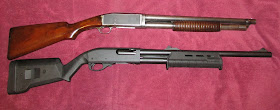car·bine noun \ˈkär-ˌbēn, -ˌbīn\From the earliest days of general-issue shoulder-fired firearms, it was quickly apparent that regular infantry arms were a little bulky to be lugged around on horseback by the cavalry, while pistols, although eminently portable and useful from horseback, had a hard time hitting targets much smaller than the proverbial broad side of a barn at any kind of distance, and thus was born the carbine.
1: a short-barreled lightweight firearm originally used by cavalry.
...
French carabine, from Middle French carabin carabineer First Known Use: 1592
By the late 19th Century,, the specialized bolt-action carbine was reaching something of a zenith, actually spawning several sub-variants.
Broadly, cavalry carbines tended to have sling hardware on the opposite side of the stock from the bolt handle, allowing the carbine to be slung securely diagonally across the back so it wouldn't be as likely to bounce off at a gallop. Since cavalry were still equipped with sabers and/or lances, cavalry carbines often had no bayonet lugs. Their bolt handles were almost always turned downwards, so as to make them less likely to snag on something while slung behind.
Carbines for engineers, mountain troops, artillery, bicyclists, and others tended to be much more like shortened infantry rifles (and sometimes were.) Sling loops tended to be in the regular place, and these carbines generally had a lug to take the standard bayonet and sometimes had a straight bolt handle like the longer infantry rifles.
The top carbine in the picture below is an Italian Moschetto Mo.91 per Truppe Speciali, made at the Brescia arsenal in 1917: It is a carbine version of the M1891 Carcano intended for special troops like artillery, engineers, and others. It has a tangent rear sight graduated from 600 to 1500 meters that folds forward into a recess cut in the wood handguard to expose a 300m fixed battle sight. If you look toward the toe of the stock, you can see a repair in the wood where the original bottom-mounted sling swivel was moved to the side during an arsenal refit at some time. The bayonet lug on the nose cap is also interesting, since it is oreinted side-to-side rather than fore-and-aft; the hole in the bayonet crossguard would be slipped over the muzzle, and then the bayonet would be rotated onto the lug until it latched. Note also that the 91 T.S. carbine has a cleaning rod threaded into the forend like the larger rifles do.
 |
| A pair of Carcano carbines. |
Both carbines here fire the Italian 6.5x52mm Carcano round from 6-shot Mannlicher-style clips, the Carcano action being heavily cribbed from the German Gew.88. The 6.5 fired a heavy-for-caliber round-nosed projectile that had a disturbing tendency to travel in one side of an enemy and out the other without doing much damage in the middle, since its cylindrical dimensions made it extremely stable and not prone to yaw. Interestingly, the Carcano fired this bullet through a barrel with gain-twist rifling, which twisted progressively faster as it went toward the muzzle, at least until WWII production exigencies made them do away with this feature.
 |
| These handy little carbines are short and compact, even by modern standards. |







